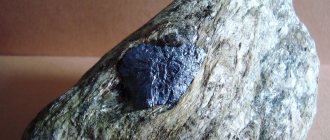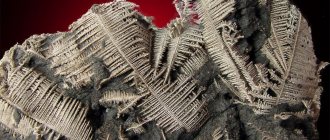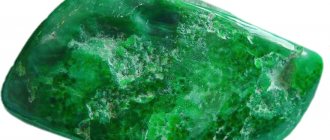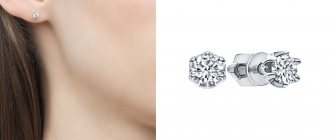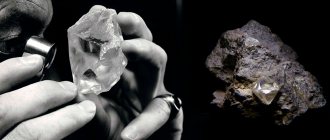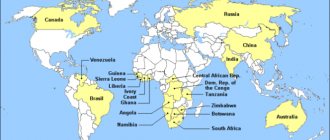The use of diamond began more than two centuries ago. Until the mid-20th century, they were used as a material for making jewelry. It is interesting that to cut one diamond, they take another diamond. The special strength of the material does not allow working on it with the help of crystalline formations of other minerals. Scientists, mineralogists, physicists and chemists have been studying the properties of the rock for a long time. They identified all the limiting characteristics and found the possibility of using stones in various production areas.
Useful properties of the gem
Diamond is the hardest substance in the world. It is a modification of the chemical element called carbon. At high temperatures, diamond changes to graphite, but if there is no access to oxygen. In a normal environment, stone begins to melt at a temperature of 800°C. Without the supply of oxygen, this process occurs at 2000°C.
List of characteristics:
- density – from 3.4 to 3.5 g/cm³;
- thermal conductivity – 2300 W (mK);
- friction coefficient – within 0.1;
- minimum compression rate;
- high modulus of elasticity.
It should also be noted that the latter figure can increase 5 times. This happens if there is no film of adsorbed gas on the surface of the gem.
When oxygen enters and air temperature is high, diamond turns into carbon dioxide.
The natural way
Diamonds are mined from “diamond” ore. This is if we talk about the standard method (but there is also an industrial, artificial one that gives endless supplies). The ore is located underground in Minecraft, at levels 1-16. The most popular levels are from 8-13. Well, the most “diamond” level is level 12. This is where the main diamond deposits are located. This is the most logical place to look for them. The local ore, if you're lucky, can give you 10 diamonds at a time. The ore is often found directly under lava. By the way, this is a serious reason not to dig under yourself - you can easily “swim”. Pecking at yourself in Minecraft is no less dangerous. The ore that you find under the lava will give you its diamonds if you pour the molten rock into a hole dug nearby with a bucket.
Ore will not give up its treasures so easily. Only a diamond pickaxe, and even an iron pickaxe, are capable of extracting the desired mineral in Minecraft. Before you dig in, you need to prepare. Here's the minimum you need to take with you:
- Pick.
- A bunch of torches.
- Sword. To defend against mobs, you need to make a sword. A sword is like a knife in the kitchen.
- Then, when you have already scouted, drag the chest underground. Why constantly rise if you can put a chest next to it and, once again, the diamond is already there. Like the sword, the chest is an indispensable thing in Minecraft.
- Stove. An extremely useful item, just like the chest and sword. By the way, the mined diamond can be given to the defense industry - the diamond sword is cooler than others. Once again, by the way, if you make a double chest, it will be an incentive to mine more cool blocks like diamond.
Use of diamond in jewelry
Not all types of diamonds are used to make precious items. The stone should have as few microcracks as possible and not be cloudy. Also pay attention to the presence of shades. A high-quality material is one that does not have a gray color.
To give the stone incredible shine, it is initially treated. The surface is polished using the same diamond. This is the only way to get the desired result. This material processing technique was discovered in India by a jeweler. Since then it has been used all over the world.
As for sawing, this was previously done using steel wire. The result was good, but it took a long time to separate the stone into pieces. Therefore, over time, sawing began to be carried out using a bronze cutter. It contains emulsion and diamond dust.
Preparation
If long hikes are not for you, then you should prepare for quite a long excavation of the earth’s bowels. Where to get diamonds in Minecraft? Rocks can be located at very different depths. In particular, it was noted that deposits of this mineral are found in large quantities at a depth of 12 blocks. Moreover, they can be found even more often near lava. But more on that later.
Before you go digging for diamond ore, you will need to make some items to take with you, namely:
- Lots of torches. From 100 pieces. Made from sticks and silicon.
Use in production
Not everyone uses diamonds in production. High-quality material has a high price, so it is irrational to use it on a large scale. Artificial diamonds are most often used in production.
Despite its advantages, diamond is a rather fragile stone.
They are obtained in several ways:
- From steam. For this, the chemical deposition method is used.
- Using high pressure and maximum temperatures.
- A substance containing a large amount of carbon is undermined.
Those stones that have not been cut are classified as industrial diamonds. They are also used to make tools.
Diamonds are made from:
- drill;
- grinding tools;
- scissors;
- cutters;
- glass cutters.
Thanks to such details, high-quality metal turning occurs. Drills for drilling oil wells are also coated with crumbs.
State and use of the diamond raw material base of the Russian Federation
(based on materials from the State report “On the state and use of mineral resources of the Russian Federation in 2018”)
The Russian Federation has the world's largest raw material base for diamonds - the reserves of precious stones in the depths of the country amount to almost 1,135 million carats. In addition, Russia has huge reserves of impact diamonds amounting to 268 billion carats.
Russia is also a world leader in the production of rough diamonds: in 2022, the country produced 43.2 million carats worth $3,983 million.
Characteristics of the raw material base
The basis of the Russian raw material base of diamonds, as well as the global one, is made up of primary deposits - kimberlite pipes - with placers being of subordinate importance. The domestic diamond raw material base is characterized by a high degree of concentration - almost 80% of diamond reserves are concentrated in the territory of the Republic of Sakha (Yakutia), where the unique kimberlite pipes Yubileinaya, Mir, Udachnaya, large pipes International, Nyurbinskaya, Botuobinskaya, Aikhal, Zarnitsa, and the Verkhne-Munskoye deposit are located . The quality of the ores of the deposits varies, with five of them characterized by a high level of diamond content - more than 3 carats/t. There are also placer diamond deposits on the territory of the republic, the largest of which are Nyurbinskaya and the river. Ebelyakh - are unique in terms of diamond content, and the Nyurbinskaya placer, in addition, is distinguished by a high average content of diamonds in the sands (5 carats/cub.m).
Another about 20% of domestic diamond reserves are concentrated in seven kimberlite pipes in the Arkhangelsk region, six of which (Arkhangelskaya, Karpinsky 1, Karpinsky 2, Lomonosov, Pionerskaya and Pomorskaya) make up the group of deposits named after. M.V. Lomonosov and are characterized by relatively low quality ores, containing on average from 0.09 to 1.4 carats/t of diamonds. Kimberlites from another deposit - the large pipe named after. V. Grib - comparable in diamond content to the pipes of the group of deposits named after. M.V. Lomonosov, but are of higher quality.
A small amount of diamond reserves (0.1% of Russian ones) are contained in small low-diamond placers in the river basin. Vishera in the Perm region, as well as in the sands of the Ingashetsky placer site of the Shelekhovskaya placer in the Irkutsk region.
In addition, in the Taimyr Dolgano-Nenets region of the Krasnoyarsk Territory, gigantic reserves of impact diamonds of technical quality have been explored in the Skalnoye and Udarnoye deposits, confined to the Popigai meteorite crater; their ores contain on average 7.1–18.5 carats/t of diamonds.
Almost all significant diamond deposits are licensed. The only large object of the undistributed fund is the Krasnopresnenskaya Pipe in the Republic of Sakha (Yakutia) with diamond reserves of 26 million carats, but it is characterized by extremely difficult operating conditions. In addition, gigantic reserves of impact diamonds have not been transferred for development; the prospects for their involvement in exploitation are low due to their location in a remote, undeveloped area.
Despite the fact that Russia has a rich raw material base of diamonds, in the future it may face a shortage of precious raw materials due to insufficient exploration reserves - the forecast resources of diamonds of the most reliable categories P1 and P2 are estimated at only 0.4 billion carats each. At the same time, significant predictive resources of a low degree of study - category P3 - in quantities exceeding 3 billion carats are localized on the territory of the country. The main part of the predicted resources of high categories (90% of category P1 and 80% of category P2) is localized in the depths of the Republic of Sakha (Yakutia), mainly on the flanks and deep horizons of developed fields. Only 12% and 15% of Russian predicted resources of categories P1 and P2, respectively, are concentrated in the primary objects of the Arkhangelsk region, mostly within the Zolotitsko-Kepinsky kimberlite field. Little prospects for the reproduction of the diamond raw material base are associated with the Mayardak area in the Republic of Bashkortostan, where the predicted resources of the P2 category are estimated at 23 million carats. In placer objects of the river basin. Vishera in the Perm region, a small amount of predicted resources of high-category diamonds is localized. In Siberia and the Central part of Russia, the predicted diamond resources are assessed only according to category P3.
State and prospects for development of the diamond industry
In 2022, 24 diamond deposits were developed in Russia, including 13 primary and 11 placer diamonds. 42.9 million carats of diamonds were extracted from the depths of the country. Diamond mining is carried out only in two regions: the Republic of Sakha (Yakutia) and the Arkhangelsk region. In the Republic of Sakha (Yakutia), which provides 77% of the domestic production of precious stones, the country's largest primary (Yubileinaya, Udachnaya, etc. pipes) and alluvial (Ebelyakh, Nyurbinskaya placer) deposits are being developed. The rest of Russian diamonds are mined in the Arkhangelsk region at two pipes of the group named after. M.V. Lomonosov and the tube named after. V. Grib.
The main volume of diamond production in Russia is provided by the ALROSA Group, which directly includes AK ALROSA (PJSC), as well as PJSC Severalmaz and JSC Almazy Anabara. Another company that is part of the ALROSA structure, PJSC ALROSA-Nyurba, has been in the process of liquidation since the fall of 2022. ALROSA Group enterprises develop all fields of the Republic of Sakha (Yakutia) and the group’s facilities named after. M.V. Lomonosov in the Arkhangelsk region. The structure of the ALROSA Group includes six production complexes that mine and process diamond-containing ores and sands: Aikhal, Nyurbinsky, Mirninsky, Udachninsky and Lomonosovsky GOKs, as well as the mining and processing complex of JSC Almazy Anabara. Primary deposits are developed by open pit and underground methods, placer deposits by open pit and dredge. Processing of ores and sands is carried out at processing plants at mining and processing plants, as well as seasonal sorting and processing factories (placer sands developed by Almazy Anabara JSC). In 2022, ALROSA Group enterprises produced 38.1 million carats. All of the company's developed fields were exploited, with the exception of the Mir pipe, the work of the underground mine at which was stopped due to an accident that occurred in August 2022.
The only diamond mining company in Russia that is not part of the ALROSA structure, which is part of Otkritie Holding JSC and operates the pipe named after. V. Grib in the Arkhangelsk region, processing ores at the processing plant of the mining and processing plant of the same name.
Due to the fact that almost all significant diamond deposits in Russia have already been put into production, the prospects for increasing the extraction of stones are small.
In October 2022, AK ALROSA (PJSC) brought into commercial production the Verkhne-Munskoye field, beginning open-pit development of the Polar Pipe. The deposit will be developed by two quarries with a total productivity of 3 million tons of ore per year (about 1.9 million carats of diamonds) with the involvement of four of the five kimberlite pipes included in it (Zapolyarnaya, Deimos, Novinka, Komsomolskaya-Magnitnaya). Reaching full design capacity is expected in 2024, the life of the mine will be 25 years. The mined ores are transported by road trains to the Udachny Mining and Processing Plant for processing.
In April 2022, AK ALROSA (PJSC), using the Aikhal Mining and Processing Plant, began mining ore at the Zarya kimberlite pipe, which should compensate for the retiring capacity of the Komsomolskaya pipe. During the year it was planned to extract 100 thousand tons of ore, and in 2022 to reach full design capacity - 1.25 million tons (about 355 thousand carats of diamonds). The development of the quarry to a depth of 300 m was planned to take place over 11 years. However, in May 2022, mining operations at the Zarya pipe (as well as at the Aikhal underground mine) were suspended due to a drop in demand for diamonds on the world market caused by the COVID-19 pandemic.
The Mayskoye indigenous deposit and the associated placer of the same name are located in the area of operation of the Nyurbinsky mining and processing plant. AK ALROSA (PJSC) planned to begin construction of the quarry in 2022, and in 2025 to put these facilities into development with full capacity (300 thousand tons of ore and sand) in 2027. The mine life of the deposits will be 15 years.
Structure of the diamond industry of the Russian Federation
, operating in the Arkhangelsk region, at the end of 2022 began mining ore at the pipe named after. Karpinsky 2 from the group of deposits named after. M.V. Lomonosov, which is planned to be developed in a single quarry with the developed pipe named after. Karpinsky 1. It is assumed that on the basis of the Arkhangelsk pipe reserves, named after. Karpinsky 1 and im. Karpinsky 2, the enterprise will operate for another 29 years. In the long term, Severalmaz PJSC plans to put into operation the remaining pipes of the group of fields named after. M. V. Lomonosov: im. Lomonosov, Pionerskaya and Pomorskaya.
ALROSA Group is also implementing several projects for the development of alluvial deposits in the Republic of Sakha (Yakutia), the largest of which is Solur-Vostochnaya.
Reproduction of the diamond raw material base
In Russia, geological exploration for diamonds is carried out annually. In 2022, two alluvial objects were put on the State Balance Sheet of Mineral Reserves of the Russian Federation for the first time: the river. Billyakh (tributaries) and stream. Ochuos. A significant increase in reserves of categories A+B+C1 was obtained on the placers of the stream. Lyaseger-Yuryakh and Nyurbinskaya, as well as the Yubileinaya pipe. The total increase in diamond reserves of categories A+B+C1 due to exploration amounted to 7.3 million carats.
The bulk of diamond exploration is provided by ALROSA Group companies. In 2018-2019, additional exploration of the Yubileinaya and Zarnitsa pipes was carried out, work was carried out at the placer deposits of the Anabar and Prilensky diamond-bearing regions (Mal Kuonamka and Maspaki, Molodo, Mayat rivers, Balagannakh stream, etc.).
Early stage exploration (prospecting and evaluation) aimed at identifying new kimberlite fields and diamond deposits is also mainly carried out by ALROSA Group enterprises in the Republic of Sakha (Yakutia) and the Arkhangelsk region. In addition, prospecting for diamonds is also carried out by Proex Service LLC in the Arkhangelsk region, Almining LLC in the Perm Territory, Diamant LLC in the Leningrad region and others.
In total, in 2022, subsoil users spent 5.2 billion rubles on geological exploration work. , 13% less than in 2017. Despite significant investments, the growth rate of diamond reserves in Russia is generally low. Over the past decade, they have only twice exceeded their loss in production: in 2009 (based on the results of additional exploration of the Internatsionalnaya and Nyurbinskaya pipes) and in 2016 (exploration of the deep horizons of the Aikhal pipe, revaluation of reserves of the Verkhne-Munskoye field)
Domestic consumption and foreign trade
Rough diamonds obtained at the ALROSA Group's processing plants are supplied to the Diamond Sorting Centers in the cities. Mirny and Arkhangelsk, where they are divided into size classes and preliminary assessed. Then they are sent to the Unified Sales Organization (USO ALROSA) in Moscow and to the Yakut Diamond Trading Enterprise (YAPTA) for final sorting and evaluation according to the Ministry of Finance price list. After evaluation, gem-quality stones from various deposits are mixed and separated into “boxes” based on similar characteristics. Technical quality diamonds are supplied to the ALROSA Group subsidiary Kommeral in Mirny, where they are partially used for the production of grinding powders. The main direction of use of rough diamonds is export.
In 2022, Russian enterprises produced 43.2 million carats of rough diamonds worth $3.98 billion. The average cost of 1 carat was $92.3.
The bulk of diamonds produced in Russia are exported. In 2022, 44.7 million carats of diamonds worth $4,695 million were sold abroad. Main export destinations: Belgium, India, UAE. The average export price of Russian diamonds in 2022 was $105/carat.
The sale of diamonds mined in Russia is mainly carried out by the ALROSA Group. In 2022, it exported rough diamonds worth $3.9 billion. Export of precious stones from the country is also carried out by Foreign Economic Association Almazuvelirexport JSC and AGD DIAMONDS JSC.
ALROSA Group's sales on the domestic market in 2022 increased by 30% compared to the previous year, amounting to $524.5 million, including diamonds worth $0.4 million sold to Gokhran of Russia. Diamonds worth $518.5 million were purchased by cutting enterprises, which included JSC PO Kristall, NPK EPL Diamond, LLC DDK, LLC S. D. Diamond", LLC "Crystaldiam", LLC "Diapur".
In addition, jewelry diamonds worth $141.1 million were shipped to enterprises that are part of the ALROSA Group: the DIAMONDS ALROSA branch in Moscow, OREL ALROSA LLC in Orel and DIAMONDS ALROSA LLC in Orel. Barnaul. Since September 2022, the largest cutting enterprise in Russia, JSC PO Kristall, has been part of the ALROSA Group.
Russia imports a small amount of diamonds every year. In 2018, the country purchased 919 thousand carats for $296.5 million. The main volume of stones was purchased in Belgium, Hong Kong, and the UAE. All of these countries are re-exporters of diamonds; stones are not mined in any of them.
The apparent domestic consumption of diamonds in Russia in 2022 can be estimated at $956 million, taking into account sales of stones within the country (including to Gokhran of Russia), supplies to cutting plants of AK ALROSA (PJSC) and imports. This is a third higher than the 2022 level, mainly due to an increase in payment deferrals for domestic consumers. Russia's share in the total consumption of rough diamonds ($15.5 billion in 2022 according to Tacy Ltd) is only about 6%.
Main conclusions
Thanks to the presence of a powerful diamond raw material base and its effective development, the Russian Federation has for a long period maintained the world leadership in the production of natural rough diamonds. However, if the current level of production is maintained, a significant reduction in the diamond raw material base is possible in the long term.
Geological exploration for diamonds is ongoing, but the rate of reproduction of diamond reserves is low. The main thing is that over the past decade, not a single deposit has been discovered that is comparable in terms of diamond potential to the objects that currently provide the bulk of stone production.
All this, taking into account the shutdown of the mine at one of the largest domestic diamond deposits - the Mir pipe, may negatively affect the prospects of the country's diamond mining industry. To create a sufficient prospecting reserve, it is necessary to carry out work in areas with localized forecast resources P3, primarily in the north and south of the Republic of Sakha (Yakutia), as well as in Siberia (Irkutsk region, Krasnoyarsk Territory) and in the north-west of the country (Arkhangelsk region and the Republic of Karelia). It is also advisable to carry out geological exploration in order to identify objects with a low diamond content, but high quality stones.
Source:
State report “On the state and use of mineral resources of the Russian Federation in 2022”
https://www.mnr.gov.ru/docs/gosudarstvennye_doklady/gosudarstvenny_doklad_o_sostoyaniy_i_ispolzovanii_mineralno_syrevykh_resursov_rossiyskoy_federatsii/
Anastasia Smolnikova for Rough&Polished
Use of gems in industry
Diamonds are widely used due to their incredible strength. Parts that are coated with crumbs have a long service life. The advantages also include low noise during operation, high speed of task completion and incredible cutting accuracy. The stone does not leave cracks, chips or other deformations on the surface.
For the manufacture of tools and components for them
Nowadays, diamond tools are used for drilling concrete. When processing such a surface, no dust appears and there is no vibration.
Often drills with diamond chips are used for:
- creating water supply holes;
- installation of air conditioners;
- taking samples from rocks.
This precious material has also found application in the space sector. Diamond is used to coat various devices so that they become highly durable and last as long as possible.
Telecommunications
This type of crystal helps to conduct several communication lines of different frequencies through one cable. It is not susceptible to sudden temperature changes and does not respond to power surges. The stone is also used in photocells and parts for optical instruments.
In order to get the desired result, it is enough to use a particle of stone that will be invisible even to the human eye.
Medicine
In this area, diamond is an indispensable item. Surgical scalpels are processed with a similar stone. Thanks to it, sharp blades make thin cuts, which is important in medicine.
The latest development of scientists is a medical laser. Its main component is diamond, which acts as a conductor.
Nuclear industry
In this area, diamond is used to create nuclear radiation. When a particle is charged, a flash is formed in the stone, from which a current pulse appears. No other gem evokes such a reaction.
Chemical and physical sphere
Since diamond, compared to other stones and materials, is not susceptible to the effects of various acids, it is used as a protective element. All parts that are created on the basis of diamond are error-free and work properly for many years.
Cut
Diamonds coming in for processing, the need for which is determined by the desire to give the stone maximum elegance and beauty, by creating an optimal shape and identifying the play of light; undergo a thorough examination, sometimes taking several weeks. After which, the future jewelry item is subjected to splitting or sawing, preliminary roughening, cutting and final polishing.
Modern computer volumetric modeling programs are used to minimize losses and predict future diamonds.
Sawing
Having replaced the splitting performed by hitting a knife, sawing allows for much better use of the workpiece. Defects identified during the inspection (internal stress, stains, cracks) can be removed or localized into a smaller product.
Typically, natural diamond is sawed using a circular saw equipped with the thinnest discs up to 0.05 mm thick, coated with a diamond powder. A rapidly rotating disk cuts the crystal in the directions of least hardness, spending several hours on this operation. A stone weighing 0.2 grams - 1 carat takes up to 8 hours of sawmill time. There is another, modern method of cutting using a laser beam, which allows you to obtain more favorable shapes and reduce weight loss of the precious mineral.
Form
In order to obtain a rough shape, sawn diamonds are subjected to friction. This is followed by cutting and polishing, as a result of which the stone takes on its final shape. Recently, this process has become mechanized thanks to the introduction of semi-automatic cutting machines into production.
Marquis
The shape of the cut, with its contours, resembles the human eye - an elongated oval, ending on both sides with two sharp corners. Which, according to the French monarch, was supposed to symbolize the insidious smile of the Marquise de Pompadour.
Pear
She's a "drop". An elegant teardrop-shaped cut, so valued by the fair sex on diamonds adorning their earrings and rings. The surface of the stone shines with 56 edges.
Oval
A very simple and common form that gives its wearers elegance by visually lengthening the parts of the body wearing the finished product.
Princess
A classic, iconic, very popular cut that gives a square shape to the processed stone, although it has a number of significant disadvantages. The diamond that adorns engagement rings is fragile in the setting, often gets lost and can be easily damaged on its edges.
Emerald
An octagonal rectangle with 56 sides, most suitable for large diamonds. Emphasizing the wealth and high level of dignity of its owner.
Asher
A cut developed in Belgium, used for stones of a high level of purity. Unlike “emerald”, it has a square shape with the same number of edges.
Radiant
Rectangular shape, covered with 61 or 77 edges, made in the form of equilateral rounded triangles.
Heart
A complicated “pear” with a wide forked base. It is a rather fragile product, the strength of which is specially increased by certain geometric proportions.
Polishing
The final stage in diamond processing, designed to finally get rid of all flaws and give the precious product smoothness and a mirror-like shine. It is performed using a rotating steel circle coated with tiny particles of diamond abrasive.
Diamonds
We're digging
So, how to get diamonds in Minecraft if you are already fully prepared? You have at least two options.
- We go down to a depth of 12 blocks and set up a room for ourselves with all the equipment indicated above. We illuminate it completely. We must install a door at the entrance. Now you have three bare walls. Start digging straight in one direction. The hole should be 2x2. Every two blocks you create a half-room, from which a branch will later be built. It will also be 2 blocks in height, but in width and length it will be 4. Then again we dig a 2x2 corridor. And so - as long as endurance is enough. It’s better not to go too far: you might fall into a cave or dig up a lake. In the same way, from the initial room we swarm to the remaining directions. After you have dug in all directions, you can move on to the branches and dig them according to the same principle as the main tunnels.
- We go down to the maximum depth and look for lava. Dig along and next to it, and also try to use the tips from the previous paragraph.



